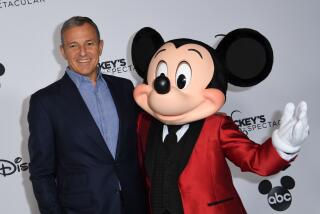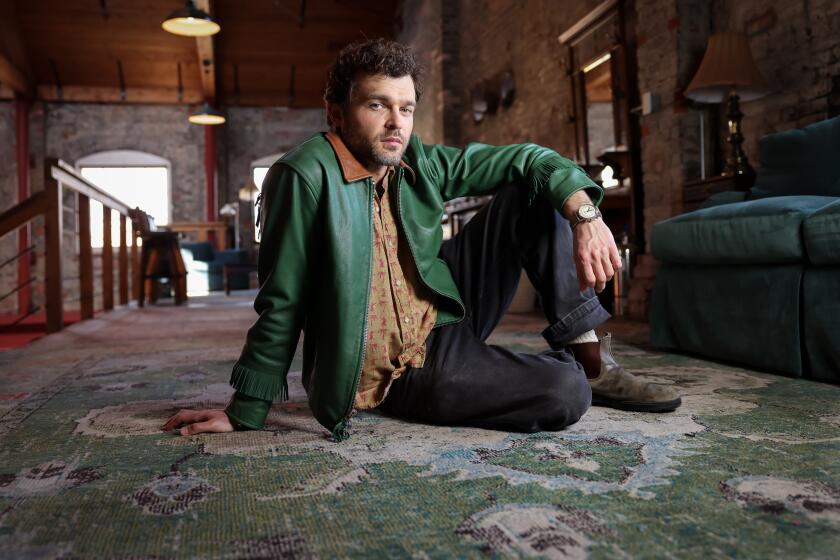Sony President Puts Best Face on Studio Woes
- Share via
In his first meeting with the U.S. entertainment media, Sony President Nobuyuki Idei began by praising Barbra Streisand’s “The Mirror Has Two Faces,” the latest release from Sony’s troubled film operation.
Playing off the title, he quipped, “So far, Sony has no face in Los Angeles.”
Idei seemed to be acknowledging that after seven tumultuous years in Hollywood, Sony still has no clear identity in the movie business. At Tuesday’s media gathering, Sony provided plenty of faces--five senior managers in all--but no answers to what went wrong and no specifics on its game plan to fix things.
As for Sony’s long-rumored desire to spin off part of its entertainment holdings or attract a strategic investor, Idei was equally vague. Experts believe Sony needs to first post a year or two of solid results before it could even consider offering stock publicly.
“I don’t deny my intention to make the company public, but I cannot tell you when,” Idei said.
He skirted questions about the chronic management chaos and big losses Sony has suffered since buying the Columbia and TriStar studios, saying it’s up to the new studio regime to review the past mistakes.
“I’m not the manager responsible,” said Idei, who was named Sony president in March 1995. “I’ve asked the new team to study the past and analyze the current situation and set objectives and make a business plan for the future.”
Idei was joined at the Culver City press conference by that new regime--Sony Pictures President and Chief Operating Officer John Calley, Co-President Jeff Sagansky and Executive Vice President Yuki Nozoe--along with Executive Vice President Robert Wynne. Idei said the purpose of his visit was to “endorse” the new management team under Calley, the former United Artists Pictures president whom Idei called “a most suitable person to run the company.”
Regarding the company’s hiring of CS First Boston as a strategic advisor, Idei said that Sony works with a number of Wall Street firms.
“Sony is a $50-billion company. It is natural that we have a relationship with investment bankers,” Idei said, adding that to strengthen its business Sony needs advice from outsiders.
Idei reiterated that the Japanese electronics giant has no plans to bail out of the business. Idei said Sony Pictures is an important part of the company’s “value chain.”
Idei used that phrase repeatedly during the 90-minute session, referring to Sony’s goal of extracting the maximum revenue from the content of its movies, TV shows and music through its various divisions such as television, consumer products and electronics.
“In order to survive the next century,” Idei said, “I think Sony as a group is going to change our business from a manufacturing-based company to a service and information-based company in the future, in addition to our core business.” Sony’s core business, consumer electronics such as the Sony Walkman, now represents 80% of the company’s revenue, with the rest from movies, television and music.
Still, Hollywood executives have long speculated that Sony will sell its studios, just as Japanese rival Matsushita Electric Industrial did when it divested MCA Inc. to Seagram Corp. last year.
Two years ago, Sony posted a $3.2-billion loss and forced out Sony Pictures Chairman Peter Guber after years of profligate spending and mismanagement. This year, Sony suffered a string of box-office disappointments, including “The Cable Guy,” “Multiplicity” and “The Fan.” But “The Mirror Has Two Faces” opened well last weekend. Sony also has high hopes for the upcoming Tom Cruise film “Jerry Maguire” and is enjoying favorable industry notice on director Milos Forman’s “The People Vs. Larry Flynt.”
The Sony executives also shed no light on whether they plan a major push into domestic TV distribution, possibly through strategic alliances, in the wake of rival Walt Disney’s acquisition of ABC, News Corp.’s global television push and Time Warner’s acquisition of Turner Broadcasting Systems.
Sagansky, a former top executive at CBS who has worked on Sony strategic matters for two years, said the company is still grappling with the question of whether Sony needs “captive distribution.” He said the company so far is having success in getting its programs aired and is pleased with its international TV ventures.
Calley, part of a team that helped turn Metro-Goldwyn-Mayer around, was hired last month to replace Alan Levine, who was forced out as president in the culmination of a yearlong housecleaning by Idei that has seen the departure of such other top Sony executives as U.S. chief Michael P. Schulhof, movie chairman Mark Canton, TriStar chief Marc Platt, Columbia President Lisa Henson and marketing head Sidney Ganis.
Idei said he doesn’t see any reason to hire an executive above Calley in the U.S. After the press conference, he shot down speculation that he wants to hire Walt Disney Co. President Michael Ovitz. Both Disney and Sony have denied it.
Calley, an advocate of collaborative management like the kind he practices at Warner Bros. in the 1970s, said that “the final decision is mine” on film budgets and giving movies the go ahead, but added “the process will be inclusive.”
Questioned about his long-term commitment to Sony, Calley, 66, said: “I see my commitment extending to my memorial service.”
Asked by a Japanese reporter about how much money he is making, Calley quipped: “We haven’t discussed that yet.”
To which Idei added: “It will be based on success.”
More to Read
The biggest entertainment stories
Get our big stories about Hollywood, film, television, music, arts, culture and more right in your inbox as soon as they publish.
You may occasionally receive promotional content from the Los Angeles Times.










